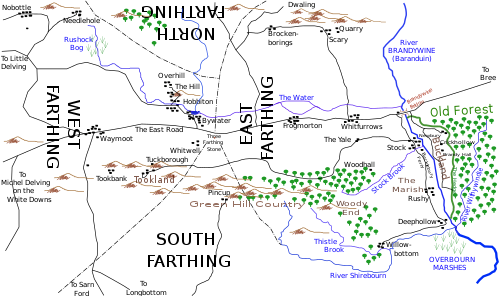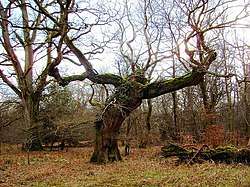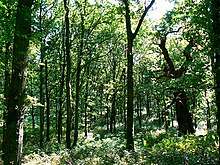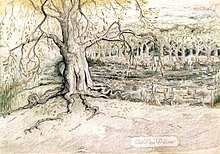Old Forest
In J. R. R. Tolkien’s fictional universe of Middle-earth, the Old Forest was a daunting and ancient woodland just beyond the eastern borders of the Shire. Its first and main appearance in print was in The Fellowship of the Ring, especially in the eponymous chapter VI, "The Old Forest".[T 1]
| Old Forest | |
|---|---|
| J. R. R. Tolkien's legendarium location | |
| Information | |
| Type | A remnant of the primordial forests of Eriador |
| Ruler | Tom Bombadil |
| Notable locations | the Withywindle |
| Location | East of the Shire |
Fictional role
Overview

The Old Forest lay near the centre of Eriador, a large region of north-west Middle-earth. It was one of the few survivors of the primordial forests which had covered much of Eriador before the Second Age. Indeed, it had once been but the northern edge of one immense forest which reached all the way to Fangorn forest, hundreds of miles to the south-east.
The vicinity of the Old Forest was the domain of three nature-spirits: Tom Bombadil, Goldberry, and Old Man Willow. The powers of these beings doubtless contributed to its survival when other forests were destroyed.[1]
Old Man Willow, along with the Barrow-wight and Tom Bombadil himself, first appeared in Tolkien's narrative poem The Adventures of Tom Bombadil, where Old Man Willow trapped Bombadil himself briefly.[T 2] Willow is portrayed as a sentient and evil willow tree with various powers including hypnosis and the ability to move his roots and trunk. Some characters of the story speculate that he may have been related to the Ents, or possibly the Huorns. However, unlike Ents or Huorns, he is portrayed more like a tree, with roots in the ground, and without the ability to move from place to place. Tom Bombadil had power over Old Man Willow, and checked the evil as much as he could, or was willing.
According to Tom Bombadil, at the dawn of time, long before even the Awakening of the Elves, trees were the only inhabitants of vast stretches of the world. Because the Elves awoke far in the East, it was still a considerable time before any other beings spread into the vast primeval forests of western Middle-earth. A handful of trees survived from this time until the present day, who are angered at the encroachment of Elves and Men and their dominion over the earth; trees who bitterly remember a time long ago when they were as Lords of vast regions of the world. Bombadil relates that of the corrupted trees of the Old Forest, "none were more dangerous than the Great Willow; his heart was rotten, but his strength was green; and he was cunning, and a master of winds, and his song and thought ran through the woods on both sides of the river. His grey thirsty spirit drew power out of the earth and spread like fine root-threads in the ground, and invisible twig-fingers in the air, till it had under its dominion nearly all the trees of the Forest from the Hedge to the Downs."[2]
In the First Age, Tom Bombadil "was here before the river and the trees".[T 3] In the Spring of Arda, plants emerge,[T 4] possibly including Old Man Willow.[T 3] In the Years of the Trees), Elves skirted the forest on their primeval migration to Beleriand and the West; they were observed by Bombadil.[T 3] Dwarves constructed the Great East Road around the north of the forest.
By the time Sauron had been defeated and driven from Eriador, most of its old forests had already been destroyed,[T 5] leaving remnants such as the Old Forest. (Other vestiges included Woody End in the Shire, Chetwood in Bree-land, and Eryn Vorn in Minhiriath. The Old Forest was now "hostile to two legged creatures because of the memory of many injuries."[T 6]
Geography, flora and fauna

The Old Forest was about 1,000 square miles in area (some 2,600 km²).[T 7] It was bordered on the east by the Barrow-downs, in the north it reached towards the Great East Road, and in the west and south it approached the Brandywine river. The Withywindle, a tributary of the Brandywine, ran through the heart of the forest, which covered most of the Withywindle's drainage basin.
This was also a 'catchment area' in another sense. The landscape, trees and bushes were aligned so that if any strangers attempted to traverse the forest, then they were funnelled towards the Withywindle,[T 1] and into the clutches of Old Man Willow in particular. The valley of the Withywindle within the Old Forest was known as the Dingle.[T 8]
The Old Forest was a type of woodland nowadays described as temperate broadleaf and mixed forest. The west and south of the forest was dominated by "oaks and ashes and other strange trees", which were generally replaced by pines and firs in the north.[T 1] Beeches[T 9] and alders[T 1][T 10] were found here and there in the forest, and willows were dominant along the Withywindle.
Many of the trees were covered "with moss and slimy, shaggy growths".[T 1] The understorey was congested with bushes and other undergrowth, including brambles. A variety of plants grew in the forest's occasional glades: grass, hemlocks, wood-parsley, fire-weed, nettles and thistles.[T 1][3]
Hobbits and the Old Forest

In one of his letters, Tolkien explained that "the Old Forest was hostile to two-legged creatures because of the memory of many injuries."[T 6] Among these two-legged creatures were Hobbits.
When Gorhendad Oldbuck and his clan of Hobbits settled Buckland, they began to encroach upon the Old Forest, thus re-awakening its hostility to two-legged creatures that had first been aroused back in the Second Age. The settlers soon found themselves under threat from the forest. They felt that the trees of the Old Forest were in some manner 'awake', and were hostile. The trees swayed when there was no wind and whispered at night, and they daunted intruding hobbits by tripping them, dropping branches, and driving them deeper into the forest. Deep within the Old Forest was the Withywindle Valley, which was the root of all the terrors of the forest; it could be a dark, evil and malevolent place.
The Bucklanders therefore planted and maintained a great Hedge (also known as the High Hay) all the way along Buckland's eastern border, which ran right along the edge of the forest. This had occurred "many generations" before the War of the Ring.[T 11]
However at length (but still "long ago" before the War of the Ring), the Bucklanders found that the Hedge was under "attack" by the forest. Trees began to plant themselves against the Hedge and lean over it. To counter this attack, the hobbits cleared a narrow strip of land on the outside of the Hedge, felling and burning many trees.[T 1] They also cleared a space some way inside the forest; this later became known as the Bonfire Glade.
The ruling family of Buckland, the Brandybucks (heirs of Gorhendad Oldbuck), owned a private gate in the Hedge, through which they occasionally dared the threshold of the Old Forest. Some of these visits seem to have been casual jaunts ("when the fit takes them"[T 11]), to satisfy the Brandybucks' inclinations as Fallohides, who were "lovers of trees and of woodlands."[T 12] But other Brandybuck expeditions must have been more practical, just plain hobbit-sense, to maintain the cleared strip. It was still in existence during the War of the Ring. At least one non-Brandybuck hobbit was reputed to visit the Old Forest: namely Farmer Maggot.[T 11]
The heir of the Brandybucks during the War of the Ring was Merry Brandybuck: a member of the Fellowship of the Ring. He had been into the Old Forest "several times",[T 1] and he had a key to the gate. On Merry's advice, Frodo Baggins (the bearer of the One Ring) decided to attempt a traversal of the dreadful forest in order to evade the pursuit of Black Riders: the forest was considered the lesser of two evils.
Old Man Willow

The evil Old Man Willow cast a spell on the hobbits, causing them to feel sleepy. Merry and Pippin leaned against the trunk of the willow and fell asleep, while Frodo sat on a root to dangle his feet in the water, before he also fell asleep. The willow then trapped Merry and Pippin in the cracks of its trunk and tipped Frodo into the stream, but the latter was saved by Sam, who, suspicious of the tree, managed to remain awake. After Frodo and Sam started a fire out of dry leaves, grass, and bits of bark in an attempt to frighten the tree, Merry yelled from the inside to put the fire out because the tree said it was going to squeeze them to death. They were saved by the timely arrival of Tom Bombadil who 'sang' to the ancient tree to release Merry and Pippin. The tree then ejected the two hobbits.[T 1]
Once safely in Tom Bombadil's house, Bombadil explained to the hobbits that the "Great Willow" was wholly evil, and had gradually spread his domination across the Old Forest until almost all the trees from the Hedge to the Barrow-downs was under his control.[T 13]
Tolkien made a careful pencil and coloured pencil drawing of Old Man Willow while he was writing the chapter "The Old Forest"; Wayne Hammond and Christina Scull call it "a fine example" of the drawings he made to support his creative writing. They note that "with a little imagination"[4] a face can just be made out on the right-hand side of the tree above the arm-like branch. Tolkien describes it as a "huge willow-tree, old and hoary"; to the hobbits it seemed enormous, though Hammond and Scull observe that it does not seem so in the drawing. Tolkien's son John suggests that it was based on one of the few unpollarded willows on the River Cherwell at Oxford.[4]
Reception
Verlyn Flieger has observed that the Old Forest contradicts Tolkien's protective stance for wild nature and his positive views of trees in particular. Indeed, although the Hobbits in The Lord of the Rings had close shaves with the Black Riders, the first real antagonist which they encountered directly is Old Man Willow. She writes also that the Bucklanders cutting and burning of hundreds of trees along the Hedge is not different from the destruction caused by Saruman's orcs in the woods around Orthanc.[5]
Tolkien's Old Forest has been compared to "Old England" in John Buchan's 1931 The Blanket of the Dark, where the protagonist Peter Bohun disappears in the English Midlands around Evesham. The West Midlands were beloved by Tolkien because the maternal part of his family, the Suffields, were from this area.[6]
Tom Shippey has proposed that the Old Forest contains a more fundamental symbolism. Frodo, the central protagonist of The Lord of the Rings, describes the forest as "the shadowed land"; Shippey draws on the context to suggest the forest could be an allusion to Death.[7]
Matthew Dickerson in the J. R. R. Tolkien Encyclopedia notes that Tolkien said that all inhabitants of Ea can be corrupted, and even "trees may 'go bad'".[T 14] Dickerson states that Old Man Willow is a prime example.[8]
Adaptations
The forest appears in the video game The Lord of the Rings: The Fellowship of the Ring.[9]
In the MMORPG Lord of the Rings Online, a quest to gather lilies for Goldberry at the foot of Old Man Willow is given to the player by Bombadil, who warns that the tree will "sing you right to sleep".[10]
See also
- Fangorn, the forest of the ent Treebeard
- Lothlórien, the forest of Galadriel and her elves
- Mirkwood, the forest of the giant spiders
References
Primary
- This list identifies each item's location in Tolkien's writings.
- The Fellowship of the Ring, book 1, ch. 6 "The Old Forest"
- The Adventures of Tom Bombadil, The Oxford Magazine, 15 February 1934
- The Fellowship of the Ring, book 1, ch. 7 "In the House of Tom Bombadil"
- The Silmarillion, ch. 1 "Of the Beginning of Days"
- Unfinished Tales, part 2 ch IV. appendix D
- Letters, #339 to the editor of The Daily Telegraph, 30 June 1972
- Based on the fold-out map of "The West of Middle-earth" in the 1st edition of Unfinished Tales (hardback). This map has a larger scale than the equivalent map in The Lord of the Rings. The metric equivalent of the Old Forest's area is 2590 square kilometres.
- The Adventures of Tom Bombadil, Preface
- The Adventures of Tom Bombadil, poem 2 verse 1
- The Adventures of Tom Bombadil, poem 2 verse 5
- The Fellowship of the Ring, book 1, ch. 5 "A Conspiracy Unmasked"
- The Fellowship of the Ring, Prologue §1
- The Fellowship of the Ring, book 1, ch. 7, "In the House of Tom Bombadil"
- Letters, #212 to Rhona Beare, unsent draft, 1958
Secondary
- Dickerson, Matthew & Jonathan Evans (2006), Ents, Elves and Eriador, University Press of Kentucky, ch.V p. 133, ISBN 0-8131-2418-2.
- The Great Willow in the Old Forest Archived 29 September 2005 at the Wayback Machine
- Hammond, Wayne G. & Christina Scull (2005), The Lord of the Rings: A Reader's Companion, HarperCollins, pp. 121–122, ISBN 0 00 720308 X.
- Hammond, Wayne; Scull, Christina (1995). J.R.R. Tolkien : artist & illustrator. London: HarperCollins. pp. 155–156. ISBN 978-0-261-10360-3. OCLC 34533659.
- Flieger, Verlyn (2000). "Taking the Part of Trees: Eco-conflict in Middle-earth". In Clark, George; Timmons, Daniel (eds.). J.R.R. Tolkien and His Literary Resonances: Views of Middle-earth. Greenwood Publishing Group. pp. 147–158. ISBN 9780313308451.
- Hooker, Mark T. (2011). "Reading John Buchan in Search of Tolkien". In Fisher, Jason (ed.). Tolkien and the Study of His Sources: Critical Essays. McFarland. p. 173. ISBN 9780786464821.
- Shippey, Tom (2003), The Road to Middle-earth, Houghton Mifflin, ch. 6, p. 190, ISBN 0-618-25760-8.
- Dickerson, Matthew (2013) [2007]. "Old Man Willow". In Drout, Michael D. C. (ed.). J.R.R. Tolkien Encyclopedia. Routledge. p. 471. ISBN 978-0-415-86511-1.
- "Video Game / The Lord of the Rings: The Fellowship of the Ring". TV Tropes. Retrieved 13 May 2020.
Lost Woods: The Old Forest level, at least in the first section. The trees constantly move around, making navigating the level very tricky.
- "A Hero's Guide to the Old Forest". MMORPG. 18 February 2009. Retrieved 13 May 2020.
After finding Tom in Chapter 9: Lilies for the River-daughter, he agrees to help you—only if you collect lilies for his wife Goldberry. Tom warns you that the lilies are guarded by the ancient tree known as Old Man Willow. Some say that this venerable tree and its dark heart is the source of all that is evil within the Old Forest.
.jpg)